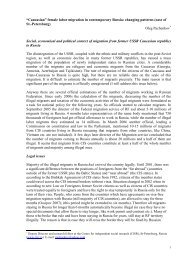THORIUM AS AN ENERGY SOURCE - Opportunities for Norway ...
THORIUM AS AN ENERGY SOURCE - Opportunities for Norway ...
THORIUM AS AN ENERGY SOURCE - Opportunities for Norway ...
You also want an ePaper? Increase the reach of your titles
YUMPU automatically turns print PDFs into web optimized ePapers that Google loves.
Thorium as an Energy Source - <strong>Opportunities</strong> <strong>for</strong> <strong>Norway</strong><br />
products that produces the heat required to melt the reactor. The Energy Amplifier as shown in<br />
figure 5.9 will probably not melt if the heat removal from the lead-bismuth coolant stops, because<br />
it contains around 8000 metric tonnes of passively cooled metal that will absorb the heat. But, if<br />
the coolant leaks from the tank the core will certainly melt.<br />
5.4.4.3 Sub-criticality and the Accelerator<br />
In an ADS, the sustainability of the nuclear fission reactions is made possible because of the<br />
presence of an external source of neutrons provided by the proton beam; the working point of the<br />
core itself is far below criticality. Two alternatives, based on well established technologies, can be<br />
envisaged in order to fulfil the indicated requirements <strong>for</strong> the accelerator:<br />
1. Super-conducting cavity LINACs, <strong>for</strong> which a vast experience exists in Europe, including on<br />
the industrial production of the cavities and of the associated RF sources, especially as a<br />
consequence of the realisation, now dismantled, of LEP200 8 at CERN and of the work at<br />
DESY (Germany) and elsewhere (Italy, France) in association with the TESLA 9 program. The<br />
most powerful LINAC is now being commissioned at the Spallation Neutron Source facility at<br />
ORNL.<br />
2. Isochronous cyclotrons, <strong>for</strong> which the world reference with respect to the ADS question is PSI<br />
(Switzerland). There is also a strong experience accumulated at G<strong>AN</strong>IL (France), CAL<br />
(France) and LNS (Italy) facilities. The guiding magnetic field can be produced either by<br />
ordinary magnets (PSI, G<strong>AN</strong>IL, CAL) or super-conducting coils (LNS).<br />
The system needed to drive an ADS represents only a reasonable extrapolation of what has<br />
already been achieved in current accelerator technology [108], [109], [110], [111], [112] and [113].<br />
An important element <strong>for</strong> the accelerator is a high reliability in continuous operation and in<br />
particular the absence of “beam glitches”, namely of short interruptions of the beam current. A<br />
beam interruption will induce very strong stresses in the window between the accelerator vacuum<br />
and the target and produce a fatigue of the reactor elements, reducing the lifetime of the system.<br />
So this topic is of first importance. The LEP200 super-conducting LINAC has demonstrated a<br />
remarkable level of continuity of operation, since a single short glitch would imply the immediate<br />
loss of the colliding beams. At PSI, however, some beam instabilities due to discharges in the RFfeed<br />
through to the cavities have been observed. It is believed that this problem can be overcome<br />
with a more advanced design of such components 10 , which are known to operate without such<br />
inconveniences in other installations (CERN).<br />
It is expected that both accelerator schemes (LINAC and cyclotron) will offer highly reliable and<br />
redundant methods to control the beam current and to switch it off extremely quickly (a few<br />
microseconds) and reliably if and when required by the sub-critical unit. However, it seems that<br />
the LINAC option is favoured by the international accelerator community [114].<br />
5.4.4.4 Technology Issues of Medium-to-High Power Spallation Targets <strong>for</strong> ADS<br />
The spallation target has to provide the highest possible neutron yield, be transparent to<br />
neutrons, and at the same time sustain a large beam power of 10 to 20 MW. In this respect,<br />
molten lead is almost an ideal candidate since it has also excellent thermodynamic properties and<br />
can contribute to cooling. The use of liquid targets is a tendency which is presently developing in<br />
8 The LEP200 programme ultimately consists of about 3.6 GeV gradient <strong>for</strong> the continuous acceleration of<br />
relativistic electrons and positrons with a current of up to 7 mA.<br />
9 The TESLA programme aims at the realisation of advanced super conducting cavities, of high gradient and lower<br />
cost in order to open the way to the realisation of a Linear Collider in the 1/2 TeV range and eventually beyond.<br />
10 New cavities are under development also at PSI.<br />
60

















